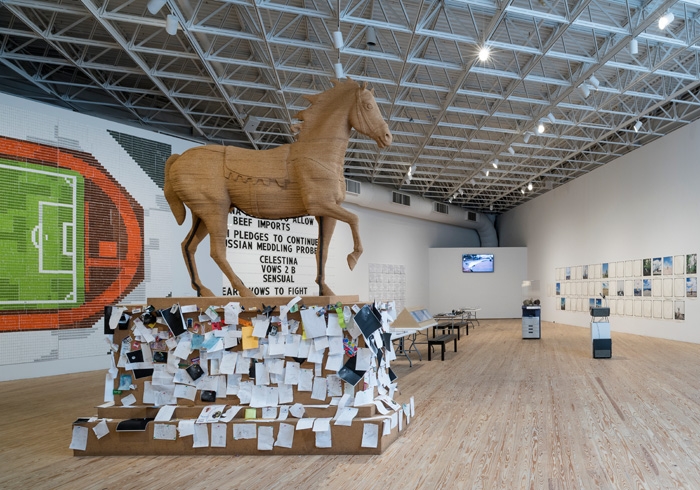Contemporary Arts Museum Houston (CAMH), 29 April – 6 August
Paul Ramírez Jonas’s first career survey in the Americas considers how we participate. That is, the Californian artist asks: how do artist and viewer influence one another, in what ways might we collaboratively write history, how do we enter narratives of exploration and how does participation redraw the lines of community? At once generous with his viewer-participants and rigorous with his interrogation of the cultural commons, Jonas’s quarter-century of sustained inquiry is, above all (and not naively), optimistic about what we can make – together – now.
The centrepiece of this exhibition, The Commons (2011), is a lifesize equestrian sculpture made of cork, upon which visitors are invited to pin their own contributions, such as drawings, notes, business cards, photographs, etc. The piece embraces ephemerality as it reenvisions the voices represented by monuments. Instead of a quotation etched in marble about military exploits, the viewer might find a sheet of paper with a child’s script reading, ‘I love nature. Take good care of it.’ Similarly, Dictar y recordar (2010) considers who writes history and how. This 24-hour event, held in Honduras, was a public invitation to write the history of the country: spoken narratives were transcribed by typewriter, then compiled into a book that the artist gifted to the National Archives of Honduras and the Smithsonian Institution’s Archives of American Art. On view at CAMH are the typewriter, the written document and a description of the event. The collaborative history existed not only in the moment of the event, but became part of an official narrative, inserted into institutions that often define our relation to the past.
Exploration is a recurring theme of Jonas’s early works. Album: 50 State Summits (2002–) includes a series of book pages with space for a photograph of the artist at the highest point of each state in the US. Some pages are filled, while others await the artist’s journey. ‘The book charts possibilities, shaping my future, and daring some trips into existence,’ he writes. Using the visual conventions of explorer imagery, Jonas situates his gesture more modestly than a moon landing or discovery of the South Pole. His exploration is one that most of us could make; he invites the viewer to envision herself there. Indeed, Jonas includes a smaller pinnacle within the exhibition: Top of the World (Red Ball) (1997) is a curved red rubber platform that the viewer can stand upon. At once intimate and imaginative, Top of the World makes exploration quotidian, and gives value to a heroism (and tourism) possible within small gestures.
No proposal of Jonas’s is so rigid that it can’t be informed by participants and viewers. In many ways, this openness replicates the act of conversation, and its assumed commitment of mutual understanding, between two people. In Public Trust (2016–) Jonas contrasts this kind of interpersonal commitment with the scepticism with which we often view promises made by politicians and institutions. Here, visitors are invited to make a promise and to swear to it (using any number of objects or books with which we make oaths). That personal promise is then written in large letters on a marquee board that includes promises made in the news that day: ‘Drug shows promise against blinding disease’ sits alongside ‘Sharad will co-explore/ share/grow with Lily’. Others, in their contrasts, show the difficulties of promises, the potential for both personal and systemic failure: ‘Atlanta commits to running on renewable energy’ is paired with ‘I promise to be true to my wife, girlfriend, and mistress’. Jonas makes a case for the individual as part of the collective; he suggests that we are active agents inside those bigger terms of art, community, politics and history. We define them, activate them, change them and make them ours. Participation, Jonas reminds us, is at once doable, ambitious, generous and hopeful.
From the September 2017 issue of ArtReview
